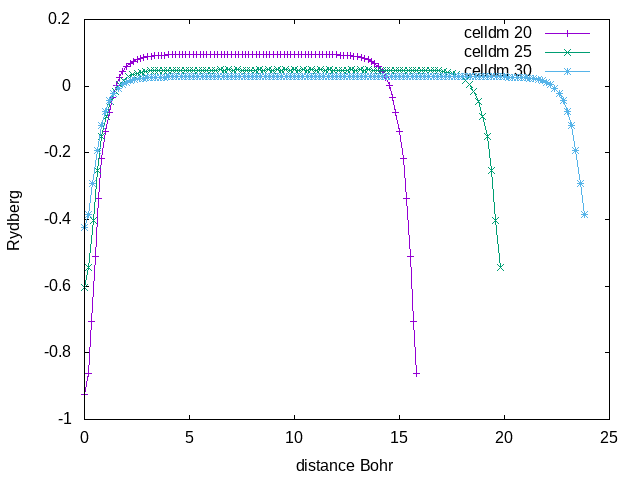Difference between revisions of "Solution LAB2 guanine 2"
(→Step 4) |
|||
| (10 intermediate revisions by the same user not shown) | |||
| Line 1: | Line 1: | ||
| − | * Back to the previous page: [[Electronic properties of isolated molecules# | + | * Back to the previous page: [[Electronic properties of isolated molecules#Exercise 2]] |
==Step 1== | ==Step 1== | ||
| Line 12: | Line 12: | ||
Repeat the same calculation of step 1 by changing the volume of your supercell (e.g celldm(1)=20,25,30). You can also use a script to automatise the runs. | Repeat the same calculation of step 1 by changing the volume of your supercell (e.g celldm(1)=20,25,30). You can also use a script to automatise the runs. | ||
| − | Then collect the results of the energy level as a function of the volume. | + | Then collect the results of the energy level as a function of the volume. You can observe a strong dependency of the eigenvalues from the volume of the supercell. |
==Step 3== | ==Step 3== | ||
| + | In order to understand the observed dependency we can plot the electrostatic potential of the system for the different volume considered. In order to plot the electrostatic potential let's use the post-processing tool of QE (pp.x) and then we plot the average potential along a direction (e.g. z direction). | ||
| + | |||
| + | [[File:average_v.png]] | ||
| + | |||
| + | Now you can look again at the eigenvalues(HOMO)calculated in the previous step taking the vacuum potential as a zero. | ||
==Step 4== | ==Step 4== | ||
| Line 25: | Line 30: | ||
[https://doi.org/10.1063/1.477923 A reciprocal space based method for treating long range interactions in ab initio and force-field-based calculations in clusters] | [https://doi.org/10.1063/1.477923 A reciprocal space based method for treating long range interactions in ab initio and force-field-based calculations in clusters] | ||
G. Martyna, M. Tuckerman J. Chem. Phys. 110 2810 (1999) | G. Martyna, M. Tuckerman J. Chem. Phys. 110 2810 (1999) | ||
| + | |||
[[File:Mt.png]] | [[File:Mt.png]] | ||
''The new function appearing in the average cluster potential energy, is the difference between the Fourier series and Fourier transform form of the long range part of the potential energy evaluated at the quantized g-vector and will be referred to as the screening function because it is constructed to ‘‘screen’’ the interaction of the system with an infinite array of periodic images.'' | ''The new function appearing in the average cluster potential energy, is the difference between the Fourier series and Fourier transform form of the long range part of the potential energy evaluated at the quantized g-vector and will be referred to as the screening function because it is constructed to ‘‘screen’’ the interaction of the system with an infinite array of periodic images.'' | ||
| + | |||
| + | *Repeat the calculations done before for different values of the vacuum and analyse again the HOMO level. | ||
| + | *How does -HOMO compares with the experimental IP (8.0-8.3 eV) | ||
| + | *Can you explain why the agreement is so poor? | ||
Latest revision as of 22:26, 18 March 2021
- Back to the previous page: Electronic properties of isolated molecules#Exercise 2
Step 1
To calculate HOMO and LUMO level perform an scf and next an nscf calculation adding empty states (e.g. nbnd = 36) Then you can inspect the eigenvalues or:
> grep "highest occupied, lowest unoccupied level"
Step 2
Repeat the same calculation of step 1 by changing the volume of your supercell (e.g celldm(1)=20,25,30). You can also use a script to automatise the runs.
Then collect the results of the energy level as a function of the volume. You can observe a strong dependency of the eigenvalues from the volume of the supercell.
Step 3
In order to understand the observed dependency we can plot the electrostatic potential of the system for the different volume considered. In order to plot the electrostatic potential let's use the post-processing tool of QE (pp.x) and then we plot the average potential along a direction (e.g. z direction).
Now you can look again at the eigenvalues(HOMO)calculated in the previous step taking the vacuum potential as a zero.
Step 4
We can isolate the system in the supercell using an algorithm to correctly treat long-range interactions. In the &SYSTEM name-list insert:
assume_isolated='mt'
This is the Martyna-Tuckerman method: A reciprocal space based method for treating long range interactions in ab initio and force-field-based calculations in clusters G. Martyna, M. Tuckerman J. Chem. Phys. 110 2810 (1999)
The new function appearing in the average cluster potential energy, is the difference between the Fourier series and Fourier transform form of the long range part of the potential energy evaluated at the quantized g-vector and will be referred to as the screening function because it is constructed to ‘‘screen’’ the interaction of the system with an infinite array of periodic images.
- Repeat the calculations done before for different values of the vacuum and analyse again the HOMO level.
- How does -HOMO compares with the experimental IP (8.0-8.3 eV)
- Can you explain why the agreement is so poor?

